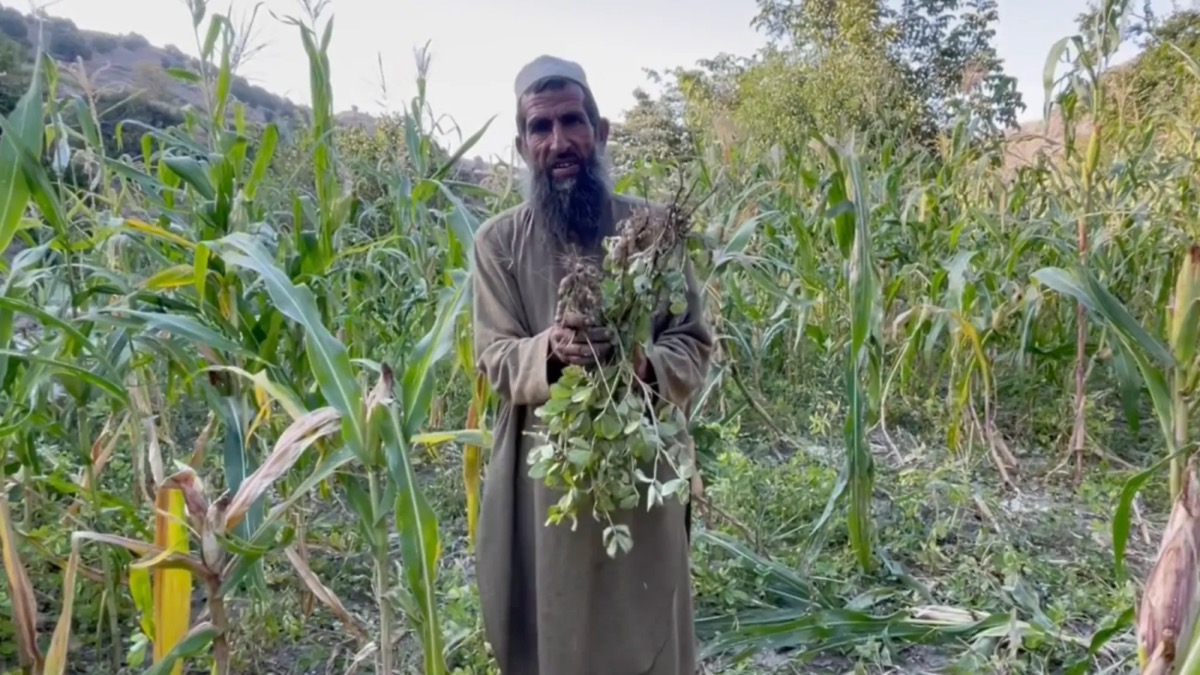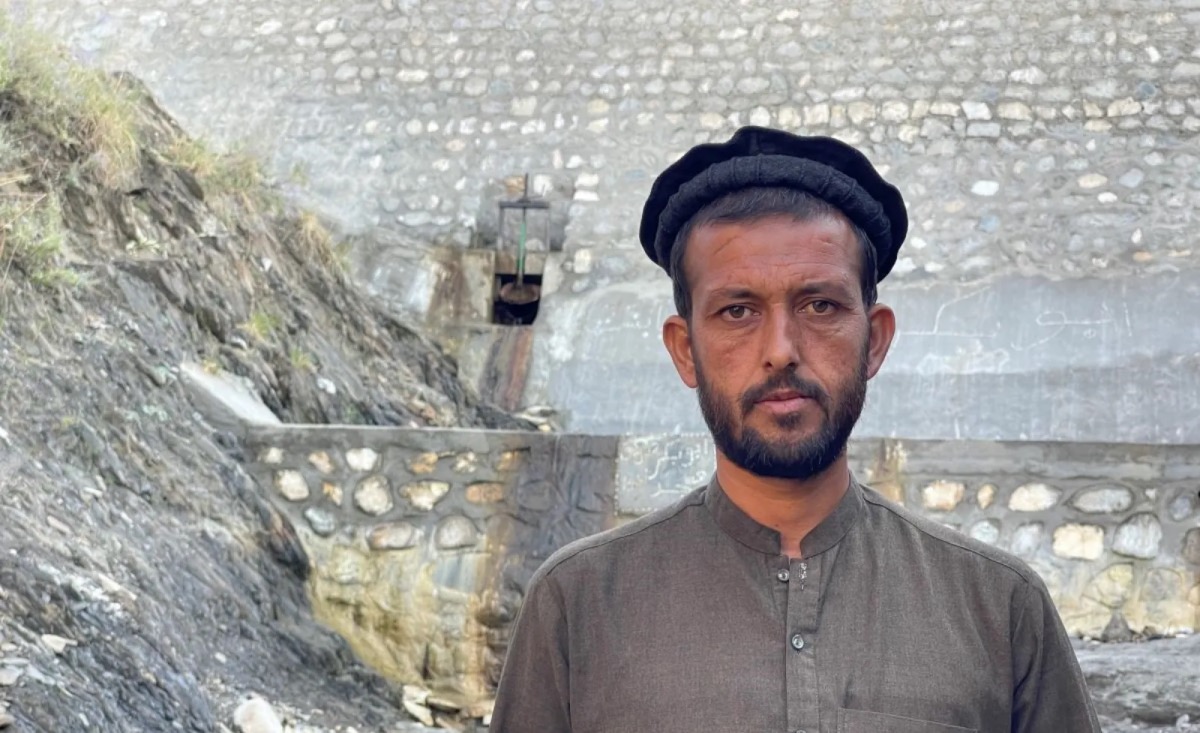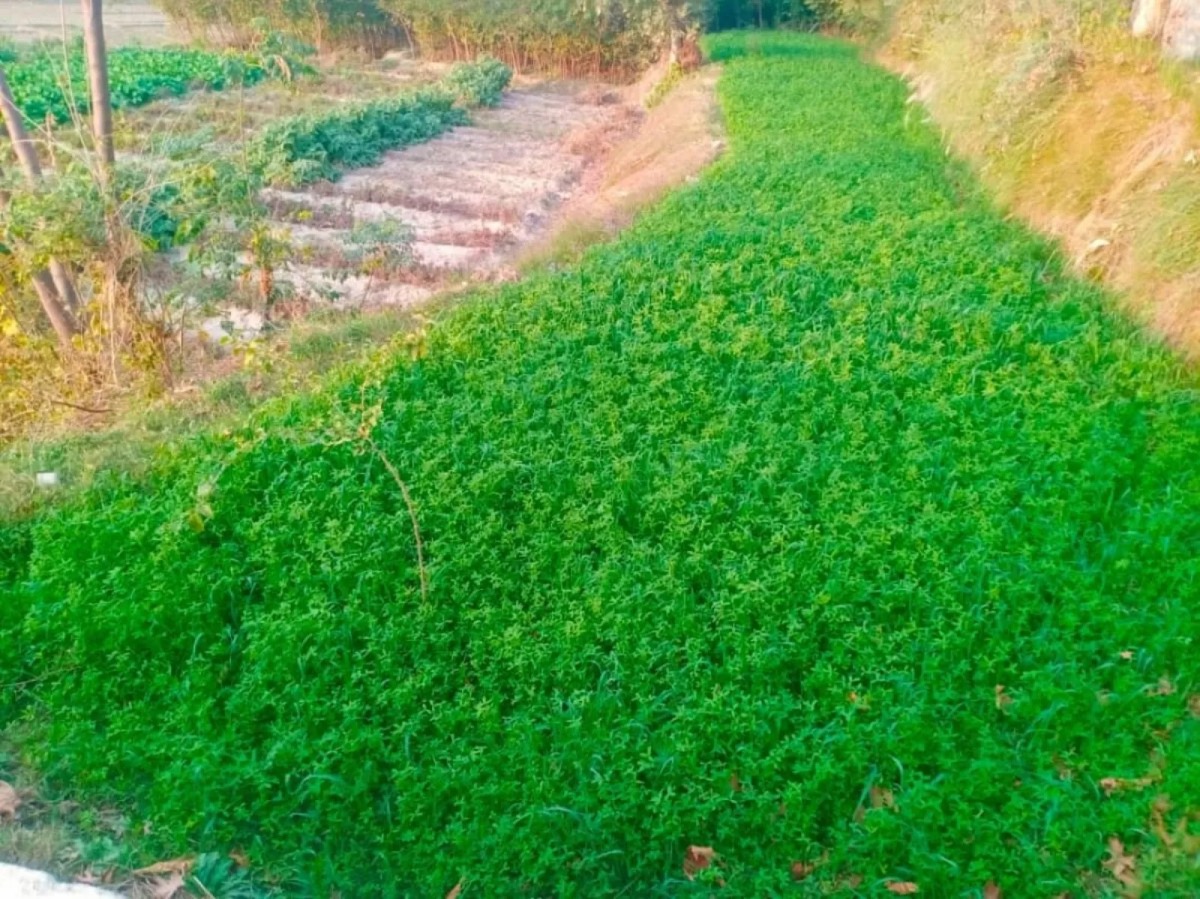
Afghanistan is among the most vulnerable countries to climate change, but has been excluded from the COP28 global climate summit. ROHULLAH TALAASH and EMMA BATHA, of Thomson Reuters Foundation, report…
Haska Mina, Afghanistan
Thomson Reuters Foundation
Two years ago, Afghan farmer Ghulam Sakhi watched in despair as his wheat and corn plants withered under an unrelenting sun in the worst drought he had seen in his 70 years.
Today not only are his crops flourishing, but his fields boast aubergines, celery, onions and potatoes. He has planted 160 apple trees and his cows, sheep and goats graze nearby.

Farmer Ghulam Sakhi holds peanut plants grown in his fields in Haska Mina district in Nangarhar province, east Afghanistan, October, 2023. PICTURE: Thomson Reuters Foundation/Rohullah Talaash
The transformation in a corner of Nangarhar Province, in eastern Afghanistan, has been brought about by an irrigation project, mostly financed by Afghans abroad, but built by locals like Sakhi.
“The area has completely changed from grey to green,” said water management expert Zmarai Kochi who helped oversee the project.
“The area has completely changed from grey to green.”
– water management expert Zmarai Kochi
“It’s been more successful than we even dreamt. We hope to replicate this across Afghanistan.”
But funding for scaling up is a headache. When the Taliban seized power in August, 2021, the international community froze most aid for development, including climate adaptation projects.
The south Asian country is one of the most vulnerable to climate change with increasing droughts and flash floods destroying livelihoods and fuelling hunger.
Average temperatures have increased by 1.8 degrees Celsius since 1950, about twice the global rate, according to the country’s National Environmental Protection Agency.
Aid agencies say climate-driven disasters are exacerbating Afghanistan’s humanitarian crisis which has left about two-thirds of the country’s 40 million people needing assistance.
Analysts also warn that Afghanistan’s climate challenges could have global repercussions – fuelling mass migration and impacting water availability in neighbouring countries.
But Afghanistan’s international isolation – no country formally recognises the Taliban government – means it will be excluded from COP28, the UN climate summit opening in Dubai on Thursday.
In Nangarhar, farmer Sakhi proudly shows off a new dam he helped construct near his home in Haska Mina district, close to the Pakistan border.
Local farmers have spent two years building canals, trenches, ponds and small dams that can now store 300,000 cubic metres of water, about 120 Olympic-sized swimming pools.
“Before this the floods would come and take away everything with them,” said Sakhi.
“Now we can control the flow of water and save it for future days. Everyone has access to water anytime, anywhere.”
The father of 12 said the project meant his annual income had soared from as little as 10,000 afghanis ($US143) to up to 60,000 afghanis.
The initiative has also reinvigorated the community. In the past, men like 35-year-old Hazratullah migrated to look for work elsewhere, including in Pakistan. Most now stay.
Hazratullah enthusiastically reeled off a list of new crops he is growing including cucumber, pumpkin and okra that would not have survived before.
“When there’s no water people are forced to abandon their homeland,” said the farmer who hopes his migrating days are behind him.
“The dam has brought stability and prosperity to our community.”
Farmers like Sakhi and Hazratullah were paid 300 afghanis a day for their labour.
Costing about $US120,000, the scheme was managed by ECOFA, a non-governmental organisation which has similar projects in three other provinces.
About 90 per cent of the money was raised by Afghans overseas via a mosque in northern Germany.
But ECOFA spokesman Kochi said such ad hoc funding was unsustainable and urged the international community to help expand the work.

Farmer Hazratullah is seen near a dam in Haska Mina district in Nangarhar province, east Afghanistan, October, 2023. PICTURE: Thomson Reuters Foundation/Rohullah Talaash
Despite the freeze on development aid, donors continue to provide emergency aid to Afghanistan via international organisations.
Najibullah Sadid, an Afghan water specialist based in Germany, said funding for climate adaptation projects could be channelled via the same organisations to bypass the Taliban.
“It makes no sense to keep giving food aid but not invest in climate adaptation projects that will help people grow their own food,” Sadid said.
“If you don’t target the root of the problem, the hunger will go on forever.”
We rely on our readers to fund Sight's work - become a financial supporter today!
For more information, head to our Subscriber's page.
Financial sanctions are not the only issue however. Afghanistan also lacks expertise after hundreds of environmental specialists quit the country when the Taliban took over.
“The Taliban are religious students. They are not experts in climate change,” Sadid said.
But he added that the Taliban appeared keen to learn and were even consulting overseas experts like himself who have criticised them.
“When we have discussions on social media a lot of them are joining. They’re listening, they’re asking questions,” Sadid said.
“They are also contacting us privately. We see they are interested.”
The Taliban said last year that climate change had caused more than $US2 billion of damage in 2022 alone.
NEPA’s climate change director, Rohullah Amin, told Context that the Taliban government had repeatedly asked to attend COP28 and the country’s exclusion was “completely wrong”.
He said Afghanistan had contributed very little to global warming, but was one of the worst-affected countries, and called for international support to tackle the threats.
A UN official said donors and UN agencies were exploring how to resume large climate projects suspended in 2021, but this was highly complex and would not involve the Taliban government.

Alfafa plants grow in Hazratullah’s fields following the construction of an irrigation project in Haska Mina district in Nangarhar province, east Afghanistan, October, 2023. PICTURE: Thomson Reuters Foundation/Rohullah Talaash
Although no Afghan officials will attend COP 28, there will be at least one voice representing the country.
Afghan climate activist Abdulhadi Achakzai has been invited as an observer. Unable to go to high-level meetings, he will work on the sidelines.
“My mission is to persuade international organisations and donors to include climate change adaptation programmes in their humanitarian assistance,” said Achakzai, founder of EPTDO, an Afghan environmental and development NGO.
Afghanistan ranks sixth equal with Sudan on the Notre Dame Global Adaptation Index of countries most vulnerable and least prepared to adapt to climate change.
But Achakzai said a lack of data masked the true picture and he would not be surprised if research put his homeland in bottom place.
He said financial sanctions meant Afghanistan would be excluded from a new “loss and damage” fund due to be launched at COP28 to help the poorest countries recover from climate-driven disasters.
But Achakzai said he was seeing growing signs that the international community recognised the urgent need to help Afghanistan tackle the issue.
“Dealing with climate change has to include everyone,” he said. “We all share one planet. No country can be excluded.”






